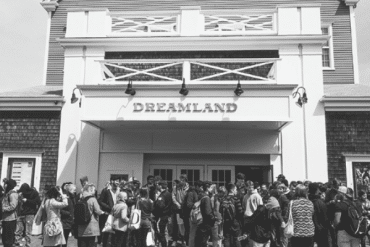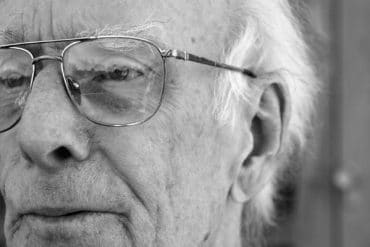The African Meeting House’s Charity-Grace Mofsen stands for the best of Nantucket in the face of one of the island’s ugliest moments.
Charity-Grace Mofsen hadn’t even reached the five corners intersection yet when she spotted the horrifying graffiti. “N—-R LEAVE!” was spray-painted in big, black letters across the African Meeting House’s white double doors. She sprang from her car, leaving her husband, Michael, at the wheel. She stumbled to the doors in a daze. A vulgar drawing was scrawled next to the racist slur. Mofsen began to tremble, stricken with anger, fear and deep sadness. Even before she became the Meeting House’s director two years ago, Mofsen loved this building and everything it represented, not just for Nantucket—but for all Americans. The graffiti felt like a stab in the heart.
 When word spread of the vandalism, the community closed like a fist on the Meeting House. People rushed in with pails of soapy water and buckets of paint. Some immediately wanted to be rid of this blemish on the face of Nantucket as if it were a cancerous lesion. But Mofsen insisted that they wait. This was a crime scene after all, and the police were just beginning to canvas the neighborhood. More philosophically, though, she felt that the words needed to be seen. “This is something that happened, and I refuse to sweep it under the rug,” she thought. “This is a problem, and it’s not new. We need to talk about it. We need to look at it. We need to see it.”
When word spread of the vandalism, the community closed like a fist on the Meeting House. People rushed in with pails of soapy water and buckets of paint. Some immediately wanted to be rid of this blemish on the face of Nantucket as if it were a cancerous lesion. But Mofsen insisted that they wait. This was a crime scene after all, and the police were just beginning to canvas the neighborhood. More philosophically, though, she felt that the words needed to be seen. “This is something that happened, and I refuse to sweep it under the rug,” she thought. “This is a problem, and it’s not new. We need to talk about it. We need to look at it. We need to see it.”
By the early afternoon, the Meeting House’s doors were repainted and its shingles power-washed, but the image was far from erased. Photos of the vandalism tore through social media and were picked up by major news outlets across the country. Senators Ed Markey and Elizabeth Warren released statements condemning the incident. The Nantucket Police declared the vandalism a hate crime and opened an investigation. Community members left flowers on the Meeting House lawn and decried the shocking crime on Facebook. At the center of it all, Mofsen quietly struggled to come to grips with the attack.
 “There has been a lot of pressure from a lot of well meaning people for me to do something (or let them do something) in the wake of the vandalism of the African Meeting House,” Mofsen wrote on Facebook, a couple days after the incident. “We are so appreciative, but we are asking for patience right now. I know many of you have asked how you can help, what you can do. Know this: standing against hate does not always require some grand demonstration. You don’t always have to march. You don’t always have to start a new hashtag. Creating new committees and yelling from the rooftops is nice, but you don’t have to do these things to make a difference.”
“There has been a lot of pressure from a lot of well meaning people for me to do something (or let them do something) in the wake of the vandalism of the African Meeting House,” Mofsen wrote on Facebook, a couple days after the incident. “We are so appreciative, but we are asking for patience right now. I know many of you have asked how you can help, what you can do. Know this: standing against hate does not always require some grand demonstration. You don’t always have to march. You don’t always have to start a new hashtag. Creating new committees and yelling from the rooftops is nice, but you don’t have to do these things to make a difference.”
Nearly a week after the incident, Mofsen is sitting in one of the pews in the African Meeting House. Every few minutes, someone comes knocking to share a word of support or condolences with her. Tonight, Mofsen is hosting a community concert at the Meeting House that was already on the schedule but has since taken on a whole new meaning in light of the vandalism. “I know people want me to say something tonight, but I’m not going to talk for long,” she says. “Whatever goes unsaid, I hope the music will fill in.”
 Over her shoulder is a large portrait of Florence Higginbotham, who purchased the Meeting House back in 1933. Higginbotham was a single black mother who went from working as a housekeeper for a family in Sconset to owning five of her own properties on the island. In a miraculous turn of fate, when Higginbotham’s employer in Sconset, Evelyn Underhill, fell on hard times at the end of her life, Higginbotham moved the old woman into one of her homes for the rest of her days. This is the communal vision of Nantucket that Mofsen believes in.
Over her shoulder is a large portrait of Florence Higginbotham, who purchased the Meeting House back in 1933. Higginbotham was a single black mother who went from working as a housekeeper for a family in Sconset to owning five of her own properties on the island. In a miraculous turn of fate, when Higginbotham’s employer in Sconset, Evelyn Underhill, fell on hard times at the end of her life, Higginbotham moved the old woman into one of her homes for the rest of her days. This is the communal vision of Nantucket that Mofsen believes in.
“We’ve got these two women from different races, different ages, different backgrounds, different economic statuses coming together and being able to find such common ground and develop such a strong bond that transcended all of their differences,” Mofsen says. “Maybe I’m naïve, but that’s what I think of when I think about the true Nantucket. That’s Nantucket history.”
Many years before Florence Higginbotham, this property was first purchased by Seneca Boston, a former slave who bought his own freedom in 1772. Two years later, Boston purchased a huge swath of land stretching from this corner of York Street to Orange Street. So it was that African Americans owned property on Nantucket before the United States was even founded.
“This history is a total game-changer,” Mofsen says. Growing up in the south, the scope of African American history she learned in class was limited to slavery and a “handful of greats” during Black History Month. She didn’t learn stories of black property owners in the 1700s, or black whaling captains, or flourishing black neighborhoods in the 1700s and 1800s. When she first encountered this history at the African Meeting House during a trip to Nantucket four years ago, Mofsen was deeply moved. “If this is affecting me in this way at thirty years old, what if we started teaching our babies this?” she says. “And I’m not talking about just black babies. I’m talking about all of our children.”
 Mofsen believes that institutions like the Museum of African American History, which acquired the Meeting House in 1989, can not only broaden our understanding of American history, but reshape the narratives society has created around race. Even on Nantucket—where Frederick Douglas first spoke publically exactly 177 years ago, where slavery was abolished a decade before it was in the rest of Massachusetts, and where an all black neighborhood called New Guinea flourished before the founding of the country—this history gets overshadowed.
Mofsen believes that institutions like the Museum of African American History, which acquired the Meeting House in 1989, can not only broaden our understanding of American history, but reshape the narratives society has created around race. Even on Nantucket—where Frederick Douglas first spoke publically exactly 177 years ago, where slavery was abolished a decade before it was in the rest of Massachusetts, and where an all black neighborhood called New Guinea flourished before the founding of the country—this history gets overshadowed.
That shadow of ignorance stretches even longer and darker off Nantucket, where many people think the island is totally devoid of diversity. “That’s a common misconception. People think that there’s nothing black here, ” Mofsen says. “That it’s not diverse here, period. That it’s the stereotypical Nantucket that you see in August… But people of color have been here free before the country was founded.”
Though she is swift to defend Nantucket’s deep history of tolerance, Mofsen doesn’t claim that the island is free of racism. “People want to say that this is not our Nantucket—but it is,” she insists. “This is a part of our Nantucket, and we have to deal with it.” Mofsen was disheartened that many on Nantucket quickly concluded that the vandal was probably just some kid acting out or looking for attention. Yes, it could very well have been a young person, she says, but to assume that is not only unfair to the island’s youth, but also it diminishes the seriousness of this hate crime and undermines the reality that racism exists on the island today.
“If you talk to a lot of people of color on the island—and I say ‘people of color,’ because it’s not just black folks—nobody was really surprised [by the vandalism]. Nobody was really surprised at all,” she says. “Because we’re used to the subtle things that happen. The subtle things that nobody will ever talk about, things that the average person who hasn’t experienced it first-hand wouldn’t even necessarily pick up on. Those are the things that dialogue will be open to now. People can start to talk about those things and work through them. Not only do I know that we can be better— but we have to be better.”
 Later that evening, Charity-Grace Mofsen is standing center stage in front of a microphone singing with her band. The Meeting House is packed with people from wall to wall—young and old, men and women, black, white and brown. The audience is a microcosm of the diverse community that’s taken shape on Nantucket over hundreds of years. Outside these walls, the island has turned its full attention to this 191-year-old post-and-beam building. But Mofsen insists that combatting racism on Nantucket must go beyond repainting a building, or attending a concert. “The potential for hate is everywhere,” she says. “It is how we deal with it that’s important.”
Later that evening, Charity-Grace Mofsen is standing center stage in front of a microphone singing with her band. The Meeting House is packed with people from wall to wall—young and old, men and women, black, white and brown. The audience is a microcosm of the diverse community that’s taken shape on Nantucket over hundreds of years. Outside these walls, the island has turned its full attention to this 191-year-old post-and-beam building. But Mofsen insists that combatting racism on Nantucket must go beyond repainting a building, or attending a concert. “The potential for hate is everywhere,” she says. “It is how we deal with it that’s important.”






